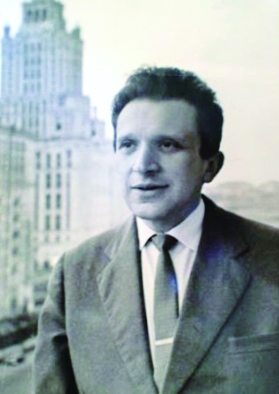SONATA NO. 4, FOR VIOLIN AND PIANO, OP. 39
Mieczyslaw Weinberg
(b. Warsaw, Poland, December 8, 1919;
d. Moscow, February 2, 1996)
Composed 1947; 18 minutes
The fourth of Weinberg’s six violin sonatas is a cyclical work in two halves of equal length: a long first movement and joined second and third movements which, finally, return to the atmosphere and material of the first. The piano writing is at first spare and tonally unclear. The violin then joins in an introspective three-part dialogue with the piano, the latter roaming widely over the keyboard, the bass line providing a ground-like anchor. The second shows the influence of Shostakovich as Weinberg takes the pomposity and nationalistic element out of a march and its militaristic fanfares, by introducing a scurrying, maniacal element to its progression. (The borrowing was mutual; Shostakovich would also borrow Polish and Jewish elements from Weinberg). As the music builds to a climax, piano chords herald a violin cadenza and then the concluding Adagio primo. Here, a serene melody high on the violin over pulsing piano chords leads into the first movement theme and a quiet fade out over pizzicato violin notes, recalling the very opening of the sonata.
 Gidon Kremer is a long-time champion of the music of Polish-born composer Mieczyslaw Weinberg. “Weinberg is very important for the development of music, a composer with the distinct voice,” he says. “People need to discover him.” The Warsaw-born 20-year-old pianist-director of the Jewish theater, where his father was a violinist and composer, fled the Nazi occupation alone, traveling to Minsk, where he continued his studies, and then Tashkent, Uzbekistan. Shostakovich was then impressed by the first of Weinberg’s 26 symphonies and invited him to Moscow, where he remained from 1943 to his death. Shostakovich was to remain a friend and ally. “I count myself his pupil, his flesh and blood,” Weinberg said. Meanwhile, all his close family and many from his wider family were murdered during World War II, and this was to haunt many of his subsequent works. These include 7 operas, including the only successful opera about the Holocaust (The Passenger), 26 symphonies, 17 string quartets and nearly 30 sonatas for various instruments, plus vast quantities of music for film, theater and radio, by which Weinberg was forced to make his living.
Gidon Kremer is a long-time champion of the music of Polish-born composer Mieczyslaw Weinberg. “Weinberg is very important for the development of music, a composer with the distinct voice,” he says. “People need to discover him.” The Warsaw-born 20-year-old pianist-director of the Jewish theater, where his father was a violinist and composer, fled the Nazi occupation alone, traveling to Minsk, where he continued his studies, and then Tashkent, Uzbekistan. Shostakovich was then impressed by the first of Weinberg’s 26 symphonies and invited him to Moscow, where he remained from 1943 to his death. Shostakovich was to remain a friend and ally. “I count myself his pupil, his flesh and blood,” Weinberg said. Meanwhile, all his close family and many from his wider family were murdered during World War II, and this was to haunt many of his subsequent works. These include 7 operas, including the only successful opera about the Holocaust (The Passenger), 26 symphonies, 17 string quartets and nearly 30 sonatas for various instruments, plus vast quantities of music for film, theater and radio, by which Weinberg was forced to make his living.